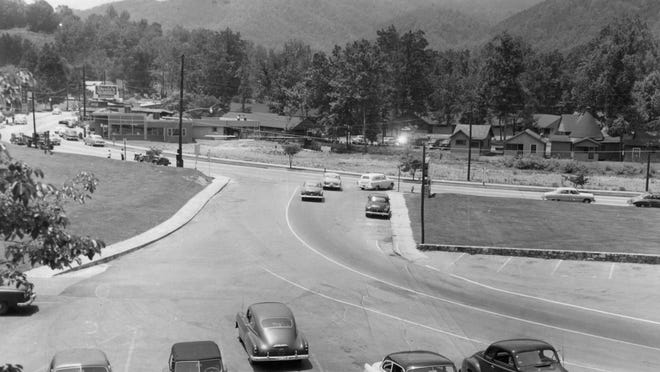
In the early 1980s, Gatlinburg’s Xanadu House stood as a celebration of progress and innovation — or poor taste, depending on your perspective. It was demolished within five years, but the reminder of a lost East Tennessee relic remains.
Those who’ve had the chance to visit may remember the home’s “float-to-relax” sensory tanks, “futuristic amenities,” and computer room, as described in the Xanadu House brochure. They’ll almost certainly remember its all-white facade and strange, domed protrusions.
When it first opened in the heart of downtown Gatlinburg, people were fascinated by the exciting possibilities of what could come in the next millennium, but others hated it; one critic in a 1982 Knoxville News Sentinel article called Xanadu “that thing on the Parkway.”
What was the Xanadu House in Gatlinburg like?
According to a 1980 article in Canada’s Times Colonist, Xanadu Houses in Gatlinburg and elsewhere were built with polyurethane foam sprayed onto large balloons, which were then removed and the door and window openings carved out.
At Gatlinburg’s Xanadu, tour groups gathered in the main room, a huge space with Styrofoam trees and a reflecting pool. The room also had a fountain that doubled as a fireplace, former tour guide Randall Crum recently told Knox News.
Crumb’s favorite room was the “Sight and Sound Room,” designed with acoustics in mind.
“They had a really great sound system,” he said. “Everything was like a starry night. … The lights would go down, the music would play, and the guests would be like, ‘Wow, wow,'” he said.
Video taken in July 1986 (the attraction’s final season in operation) shows additional features such as an indoor slide, early induction cooktops and combined washer/dryer units, much of which Krumm said was developed by the German company Gaggenau-Hausgeräte.
More Surreal Real Estate: This Midcentury Modern House Might Be the Next Best Thing to Living in the Sunsphere
How did Xanadu House end up in East Tennessee?
The story of Xanadu House began in 1979 in Wisconsin Dells, Wisconsin, where the first attraction of its kind was built. The project was led by Bob Masters. Masters lived in his polyurethane home and realized that his home was sparking curiosity among locals and could be an entrepreneurial opportunity, The Palm Beach Post reported in 2000.
Due to conflict between the project’s creators, the Xanadu House in Wisconsin was handed over to partner and co-creator Tom Gassel, while Masters began work on a second Xanadu House in Kissimmee, Florida, in collaboration with architect and futurist Roy Mason.
Lane Jennings told Knox News that Mason was fascinated by his innovative approach to architecture. Jennings co-authored the book “Xanadu: The Computerized Home of the Future and How to Make It Yours Today!” with Mason and Robert Evans. Mason was instrumental in incorporating futuristic technology into the Kissimmee attraction, which opened in 1983.
Stories vary about who built Gatlinburg’s Xanadu House: Jennings remembers Mason being involved, and Fred Hardwick, who managed Tommy Bartlett’s Water Circus in Pigeon Forge (which had a financial interest in Xanadu in the 1980s), remembers Gassel as its designer.
Although it’s often said that the Gatlinburg building was the last to be built, it actually opened to the public in June 1982, about a year earlier than the Kissimmee building.
The theme of the 1982 World’s Fair in Knoxville was “Energy Changes the World,” and this concept gave birth to some of the city’s most enduring food favorites, including Sunsphere and Petros (short for oil) Chili and Chips.
Although Xanadu is several miles from the fairgrounds, it was built with an emphasis on energy efficiency and has “virtually zero electric bills,” which fits with the theme of the fair, Crum said, and the Gatlinburg attraction saw unusually high numbers of tourists during the Knoxville World’s Fair.
Repulsion and Exclusion
“Many residents feel that Xanadu’s appearance is a far cry from the ‘majestic pleasure dome’ celebrated in Samuel Taylor Coleridge’s poem ‘Kubla Khan,'” the News Sentinel reported on June 13, 1982.
Sure, the house was named after the Coleridges, but the literary allusions weren’t enough to grab public attention: “A lot of people called it the ugliest place on the Strip,” Crum recalls.
Less than a month after Gatlinburg’s Xanadu opened, a petition was presented to the Gatlinburg City Council calling the building “a blot on our beautiful city” and asking for zoning laws to be changed, The News Sentinel reported on June 23, 1982.
In addition to aesthetic complaints, the appeal of Xanadu’s innovations was fading: by 1986, much of its technology had already been made public.
“The home of the future has become the home of the present,” Crum said.
After Xanadu closed, it was slated to be replaced by a mini-golf course, and “the owners said they would strive to maintain a rustic, country look that, unlike the house, would blend into the mountain backdrop,” the News Sentinel reported in 1986.
More recently, Xanadu’s old site housed the Sugar Land Wedding Chapel on the parkway near the Over Mountain Tramway Mall, which has since been converted into a parking lot.
Hayden Dunbar is a Storyteller reporter and can be reached at hayden.dunbar@knoxnews.com.
Please support strong local journalism by subscribing at knoxnews.com/subscribe.


